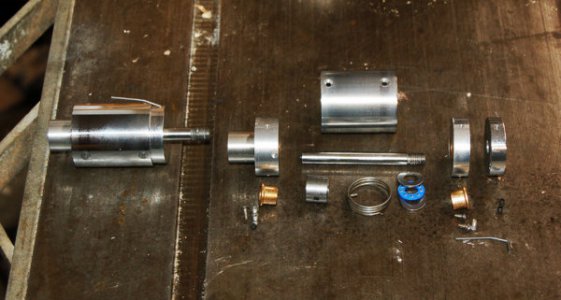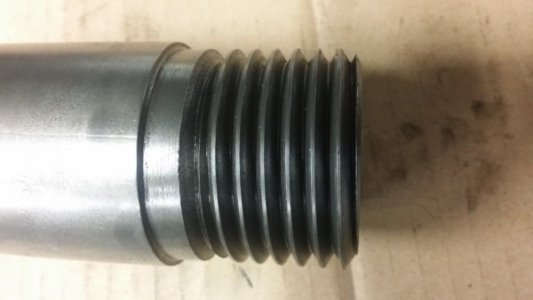This project has been going on for nearly a month. I've been tasked to make some 120 inch ounce torque meters for the Rubber Band Model Airplane fliers. Seems they want to know how much torque they are putting on the "motors" of their airplanes. I've made maybe 20 of these in the past couple of years, so I set out to make a dozen. Well, my scrap rate being what it is, I started 14 of them. I've got all the parts made for them, and a couple assembled, thought some of you here might enjoy my travail.
The entire unit is assembled on the left. After I ship it to my son for sale he applies a scale (purchased mm scale just the right length to accommodate the circumference of the tube) that goes from 0 to 12 with ten marks between each number.
Note the pointer on the unit, attached to the right end. This pointer is secured to the end cap which is secured to the output shaft (5/16 by 3" with threads on the right end. This assembly floats inside the rest of the unit. The spring and its collar are fixed to the shaft, the other end of the spring is fixed to the round T shaped piece on the left end. The entire unit is mounted on the end of a hand cranked device to wind the propeller rubber. As the winder is turned the whole torque meter turns with it. As the rubber band gets tighter it winds the spring inside, moving the pointer relative to the scale. The operator has to stop winding to see the resulting torque reading.
The six 4-40 flathead Philips head screws, six 5-40 1/8 set screws, the two bronze bushings and the thrust bearing (blue) are purchased items. I fabricate all the rest from purchased stock.
There's a great deal of relief on my part when I've got all the parts made. I can assemble one in 15 minutes when an order comes in.
Copied from where I first posted it in error.



